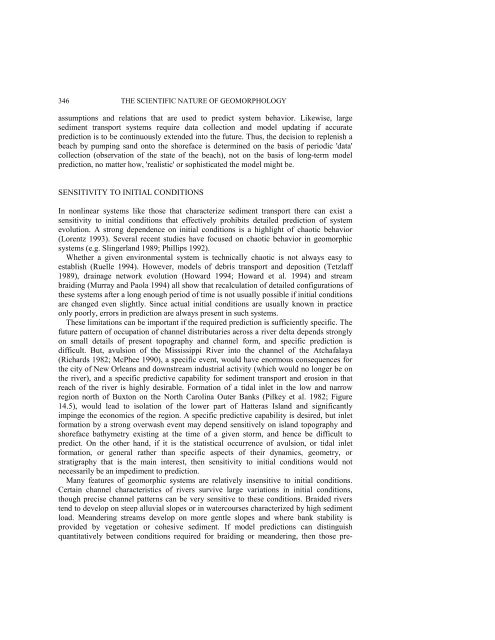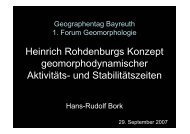Chapter 14 - Limitations on Predictive Modeling in Geomorphology ...
Chapter 14 - Limitations on Predictive Modeling in Geomorphology ...
Chapter 14 - Limitations on Predictive Modeling in Geomorphology ...
Create successful ePaper yourself
Turn your PDF publications into a flip-book with our unique Google optimized e-Paper software.
346 THE SCIENTIFIC NATURE OF GEOMORPHOLOGY<br />
assumpti<strong>on</strong>s and relati<strong>on</strong>s that are used to predict system behavior. Likewise, large<br />
sediment transport systems require data collecti<strong>on</strong> and model updat<strong>in</strong>g if accurate<br />
predicti<strong>on</strong> is to be c<strong>on</strong>t<strong>in</strong>uously extended <strong>in</strong>to the future. Thus, the decisi<strong>on</strong> to replenish a<br />
beach by pump<strong>in</strong>g sand <strong>on</strong>to the shoreface is determ<strong>in</strong>ed <strong>on</strong> the basis of periodic 'data'<br />
collecti<strong>on</strong> (observati<strong>on</strong> of the state of the beach), not <strong>on</strong> the basis of l<strong>on</strong>g-term model<br />
predicti<strong>on</strong>, no matter how, 'realistic' or sophisticated the model might be.<br />
SENSITIVITY TO INITIAL CONDITIONS<br />
In n<strong>on</strong>l<strong>in</strong>ear systems like those that characterize sediment transport there can exist a<br />
sensitivity to <strong>in</strong>itial c<strong>on</strong>diti<strong>on</strong>s that effectively prohibits detailed predicti<strong>on</strong> of system<br />
evoluti<strong>on</strong>. A str<strong>on</strong>g dependence <strong>on</strong> <strong>in</strong>itial c<strong>on</strong>diti<strong>on</strong>s is a highlight of chaotic behavior<br />
(Lorentz 1993). Several recent studies have focused <strong>on</strong> chaotic behavior <strong>in</strong> geomorphic<br />
systems (e.g. Sl<strong>in</strong>gerland 1989; Phillips 1992).<br />
Whether a given envir<strong>on</strong>mental system is technically chaotic is not always easy to<br />
establish (Ruelle 1994). However, models of debris transport and depositi<strong>on</strong> (Tetzlaff<br />
1989), dra<strong>in</strong>age network evoluti<strong>on</strong> (Howard 1994; Howard et al. 1994) and stream<br />
braid<strong>in</strong>g (Murray and Paola 1994) all show that recalculati<strong>on</strong> of detailed c<strong>on</strong>figurati<strong>on</strong>s of<br />
these systems after a l<strong>on</strong>g enough period of time is not usually possible if <strong>in</strong>itial c<strong>on</strong>diti<strong>on</strong>s<br />
are changed even slightly. S<strong>in</strong>ce actual <strong>in</strong>itial c<strong>on</strong>diti<strong>on</strong>s are usually known <strong>in</strong> practice<br />
<strong>on</strong>ly poorly, errors <strong>in</strong> predicti<strong>on</strong> are always present <strong>in</strong> such systems.<br />
These limitati<strong>on</strong>s can be important if the required predicti<strong>on</strong> is sufficiently specific. The<br />
future pattern of occupati<strong>on</strong> of channel distributaries across a river delta depends str<strong>on</strong>gly<br />
<strong>on</strong> small details of present topography and channel form, and specific predicti<strong>on</strong> is<br />
difficult. But, avulsi<strong>on</strong> of the Mississippi River <strong>in</strong>to the channel of the Atchafalaya<br />
(Richards 1982; McPhee 1990), a specific event, would have enormous c<strong>on</strong>sequences for<br />
the city of New Orleans and downstream <strong>in</strong>dustrial activity (which would no l<strong>on</strong>ger be <strong>on</strong><br />
the river), and a specific predictive capability for sediment transport and erosi<strong>on</strong> <strong>in</strong> that<br />
reach of the river is highly desirable. Formati<strong>on</strong> of a tidal <strong>in</strong>let <strong>in</strong> the low and narrow<br />
regi<strong>on</strong> north of Buxt<strong>on</strong> <strong>on</strong> the North Carol<strong>in</strong>a Outer Banks (Pilkey et al. 1982; Figure<br />
<str<strong>on</strong>g>14</str<strong>on</strong>g>.5), would lead to isolati<strong>on</strong> of the lower part of Hatteras Island and significantly<br />
imp<strong>in</strong>ge the ec<strong>on</strong>omics of the regi<strong>on</strong>. A specific predictive capability is desired, but <strong>in</strong>let<br />
formati<strong>on</strong> by a str<strong>on</strong>g overwash event may depend sensitively <strong>on</strong> island topography and<br />
shoreface bathymetry exist<strong>in</strong>g at the time of a given storm, and hence be difficult to<br />
predict. On the other hand, if it is the statistical occurrence of avulsi<strong>on</strong>, or tidal <strong>in</strong>let<br />
formati<strong>on</strong>, or general rather than specific aspects of their dynamics, geometry, or<br />
stratigraphy that is the ma<strong>in</strong> <strong>in</strong>terest, then sensitivity to <strong>in</strong>itial c<strong>on</strong>diti<strong>on</strong>s would not<br />
necessarily be an impediment to predicti<strong>on</strong>.<br />
Many features of geomorphic systems are relatively <strong>in</strong>sensitive to <strong>in</strong>itial c<strong>on</strong>diti<strong>on</strong>s.<br />
Certa<strong>in</strong> channel characteristics of rivers survive large variati<strong>on</strong>s <strong>in</strong> <strong>in</strong>itial c<strong>on</strong>diti<strong>on</strong>s,<br />
though precise channel patterns can be very sensitive to these c<strong>on</strong>diti<strong>on</strong>s. Braided rivers<br />
tend to develop <strong>on</strong> steep alluvial slopes or <strong>in</strong> watercourses characterized by high sediment<br />
load. Meander<strong>in</strong>g streams develop <strong>on</strong> more gentle slopes and where bank stability is<br />
provided by vegetati<strong>on</strong> or cohesive sediment. If model predicti<strong>on</strong>s can dist<strong>in</strong>guish<br />
quantitatively between c<strong>on</strong>diti<strong>on</strong>s required for braid<strong>in</strong>g or meander<strong>in</strong>g, then those pre-








